Aggelos review – A cut above the rest
Aggelos is a classic-style platforming game with a lot of heart and a large amount of depth that tells a story about a boy saving a kingdom from evil.
Taking obvious inspirations from Wonder Boy and Zelda II, Aggelos is an action-rpg with big shoes to fill. I am happy to report that it nails the feel and style of both, flawlessly. From the wide repertoire of sword skills and combat abilities to the varied NPCs and side-quests, Aggelos does find a way to set itself apart and do its own thing, while still staying true to its roots.
Aggelos begins with you meeting Princess Lys, who tells you that she escaped from the evil Valion (who kidnapped her) and of the perils about to befall the kingdom. Apparently the main entrance to the castle is blocked — so appropriately, you have to take a secret entrance into it from a cave under the forest.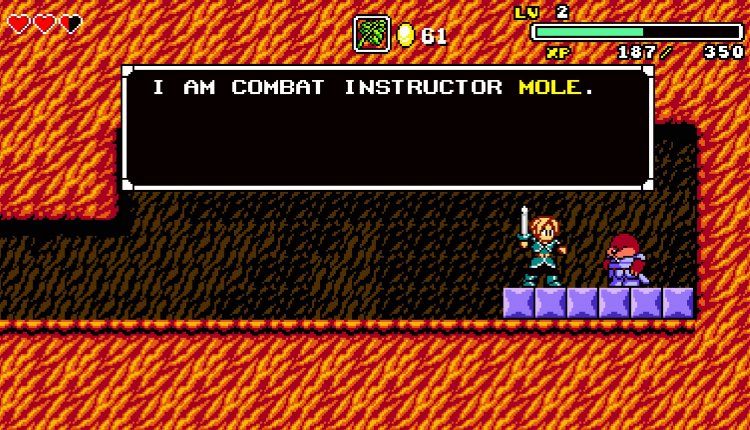
Through the forest, you battle spiders, flowers and snakes in order to make your way down into the caves below. It is within these caves that you find the ‘Combat Instructor Mole’, who gives you the ‘Mole Scroll’ which then allows you to do a downwards attack with your sword. This attack can destroy blocks below you, plus attack or bounce off of enemies. With this upgrade, you may now proceed deeper in the caves to the secret entrance into the castle.
Once inside the castle, you are greeted by King Gentel. He states that someone must recover the four elements in order to defeat Valion and you are (conveniently) selected for the quest. The royal Seer then gives you the key to the kingdom and tells you to find them if you ever need any help. Normally this would be where you would putter around, looking for the next area to go to, but in Aggelos, you have a Seer! The Seer will tell you (based on what part of the game you are playing) where to go and what to do next. It’s a nice addition to the game that certainly saved me a bunch of times when I got lost. The information is always vague, but it’s enough to get you on the right track, at least.
Seer or otherwise, you are lead to a door down in the cavern you visited earlier, which takes you on the path to the Earth Temple — the first of four temples housing powers related to their respective element. Once inside, you are met with glowing flowers (that do damage) and various other odd and aggressive creatures. Shortly afterwards, you find yourself standing within the temple walls.
One of your goals within this temple (and all the other temples) is to gain an elemental ring that imbues you with magical power. As you make your way through the temple, you eventually stumble upon the Earth Ring. The Earth Ring allows you to throw a sort of ‘platform magic’ at glowing ‘wisps’ (that you will have so far seen throughout the area outside of the temple and within) to create a temporary magical platform. You can also use this magic to attack enemies; if you hold the button, you can turn them into platforms too!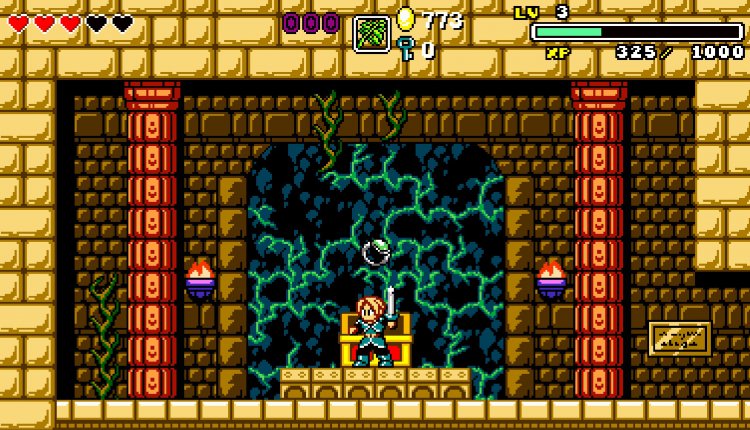
Once outside the room you gained the ring in, you are required to use your new power in order to traverse back from whence you came. An enemy is stationed just high enough to be used as a magical platform, but the platform itself is too high to jump to. This is a clever tactic that showcases the ring’s power and allows the player to experience the new gameplay mechanic without the typical hand-holding found in most tutorials.
A couple more puzzles here and there using your new powers to gain previously unreachable heights, and you are off to fight the boss: a skull with glowing green eyes. The skull is suspended on the ceiling and you must attack the spectres that it summons to fill up your magic meter. When you throw enough magic at him to finally knock him down, the real fight begins.
The skull is fairly simple as it just spams a few attacks at you, but most of his damage comes from trying to jump on top of you as he bounces around the room. Many sword swipes and dodges later, the skull is no more as it explodes into a fountain of collectible coins and you even gain an extra heart for your troubles. Finally, you head to the ‘Earth Element’ room and retrieve your prize. One down, three to go!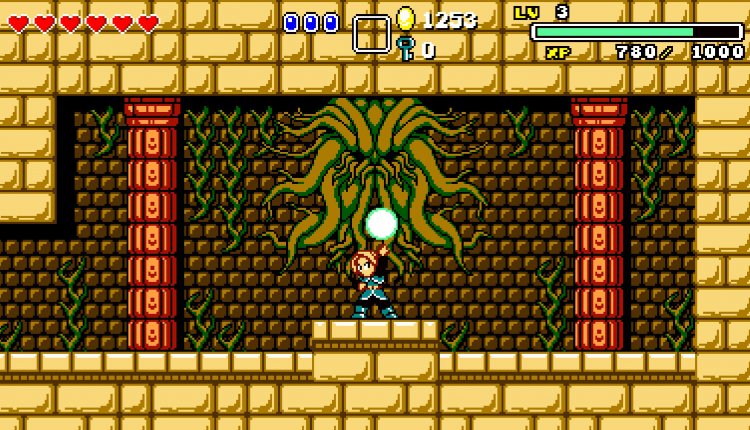
You are then set off to find all the other elements and use them to defeat Valion and save the kingdom. This open-ended approach is both a blessing and a curse. It’s nice to have that freedom, but at the same time, the map system is not grid-based, but rather literally a map with loosely defined areas. This leads to going to places that you don’t want to be, thinking that they will lead to the appropriate area, but more often than not, you forget where to go in the labyrinth of interconnected screens. To their credit, at least they include a teleport feature at every save point that will instantly take you to any of the other (albeit sparse) save points you’ve accessed so far.
The gorgeously rendered pixel art defines so well the era of gaming that a game like Aggelos would have came from. Each character or enemy is well-detailed and animated and the world never feels too empty. I found myself taking more screenshots than necessary because the art really does just look that good.
Musically, the tunes in Aggelos are great. They all seem to tie together and you’ll find yourself accustomed to the various tunes that play during the overworld, towns, and even the boss fights. I have no complaints about the style of the music, but the music in the ‘Air Temple’ was way too tinny for my tastes. This combined with the overall difficulty of the game had me reaching for the mute button after the tenth or so try. The overworld music also tends to get repetitive as that’s where you spend most of your time, but it’s not too bad.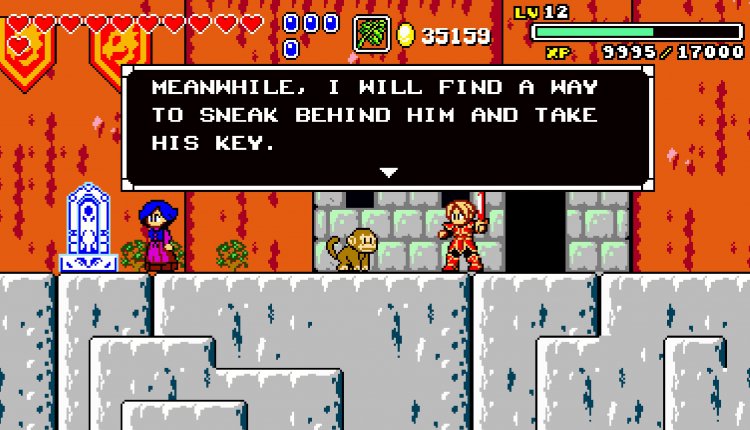
The monkeys in the game really are some of my favorite characters. At first, you can’t communicate with them and the ones around the environment will annoyingly swipe coins from you every time you come near. However, later on in the game, you get a book that allows you to understand all the creatures in the game, which allows you to translate what they have been saying the entire time. You then can undergo quests to solve their problems. My favorites are a monkey who was hiding in a tree, that hitches a ride on your back, and another monkey that you take control of that sneaks around the environment in order to grab a key for you without the guard noticing. These two instances are some of my favorite parts of the game.
I want to take some time to specifically point out some limitations of the controls. There are some parts in Aggelos that are just downright hard, requiring precise button presses and extreme platforming skills. Conveniently, most of these situations are housed within optional challenges. However, the fact remains that the use of a keyboard is almost required in certain parts of the game where you are required to input multiple directional commands and unfortunately, this is something an analog stick simply can’t keep up with. I managed through, but we’re talking about forty or so tries to finish one fairly small challenge.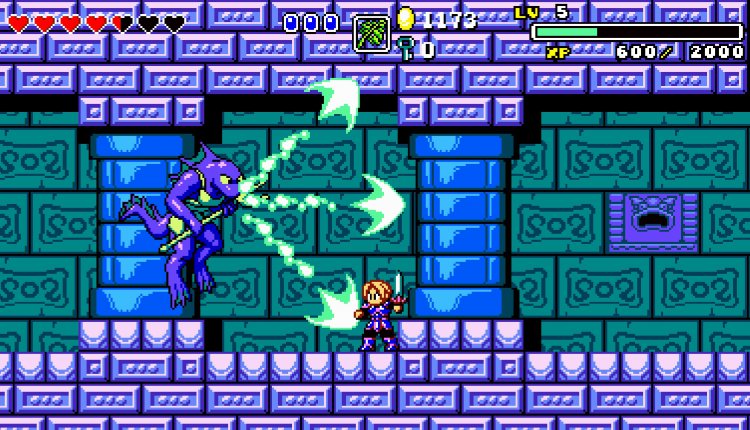
The game itself also starts off almost annoyingly easy, with enemies falling left and right to a single swipe of your sword. After reaching the third temple however, the game just becomes stupidly hard. There is a leveling up system in place, but that will not do anything for you but make you hit for slightly more damage with your sword and replenish your health after each level. It’s something you can certainly work through through trial and error, but there’s a lot of patience required and for some, that may be too much.
All that being said, I think that overall, the game is great. While there are some problems with the difficulty and controls in some parts of the game, it’s a gorgeous action platformer with pumping chiptunes that really hits its key points. It’s not terribly long, at about five or six hours, but the ‘classic difficulty’ more than makes up for it as you feel triumphant at overcoming each challenge along the way.
Aggelos is currently available on Steam. It is planned for release on Xbox One, Playstation 4 and Nintendo Switch in 2018. Follow Storybird Games on Twitter for more information.
Comments are closed.